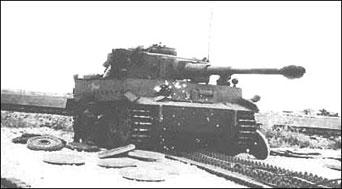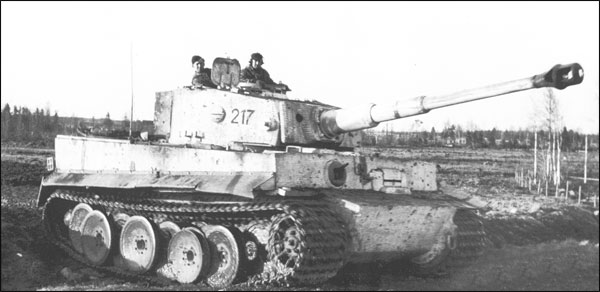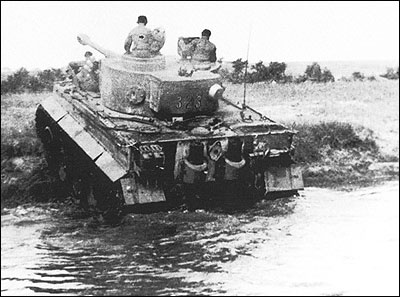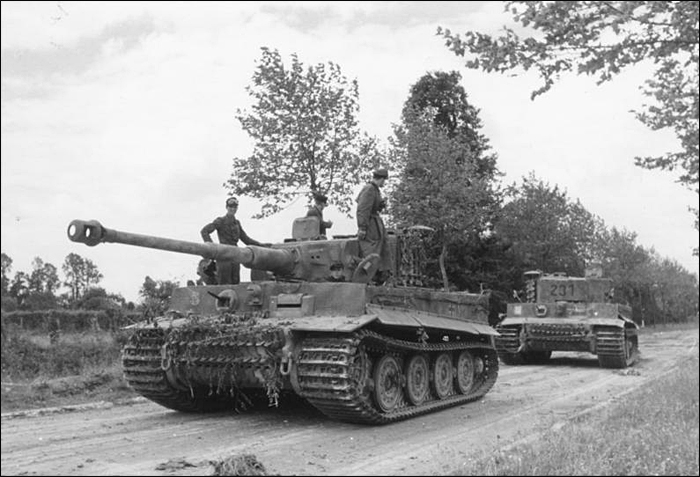 PzKpfw VI Tiger I, or SdKfz 181.
Mobility Much have been said about the Tiger's maneuverability, that the Tiger was a "lumbering monster", or that "it could barely move", but the truth is that it is all myth. The Tiger I was very maneuverable for its weight and size, and superior to the Sherman in muddy terrain, despite its size and weight. Tigers, like all German tanks, used regenerative steering, hydraulically operated - the separate tracks could be turned in opposite directions at the same time, so the Tiger I could neutral steer (pivoting in place) , and completely turn around in a distance of 3.44 meters (11.28ft). This used to take by surprise many unlucky enemy crews! Also, the reality is that the Tiger I was not slow at all: The Panzer IV road speed was 40 km/h. Cross country speed was 20 km/h. The Panzer III (Ausf E to N) road speed was 40 km/h. Cross country speed was 18 km/h. The Tiger I road speed was 38 km/h. Cross country speed was 20 km/h.
The only german tank that was faster than the Tiger I was the Panther, with a road speed of 46 km/h and a cross country speed of 24 km/h. But, overall, the Panther was not more reliable than the Tiger I, and the Tiger I had better protection than any Panther model, due to the quality and thickness of its armor, relative to the opponents tank and anti-tank guns calibers and penetration power. The table below demonstrate that the percentage of Tigers operational at the Front was about equal to the PzKpfw. IV and as good as or better than the Panther.
However, the Tiger I was not free from problems either, and the most common were those related to the transmission - the weight of the Tiger was too much for the German transmissions available at the time, so Henschel designed a special one to work with the Maybach gearbox with eight forward speeds. The result was a surprisingly light set of controls for the driver, but that had a tendency to breakdowns, if adequate periodic preventive maintenance was not done. Since it was not always possible to do this preventive maintenance as required, many Tigers broke down and had to be destroyed and then abandoned.
This fact is evidenced by the following excerpt from the Experience Report of the Tiger Abteilung 506, dated 15 January 1944: "During long term operations, which stretched over 12 days, time for care and maintenance of the Tigers was too short and losses were correspondingly high. On 2 January 1944, the Abteilung went into action with 13 Panzers. Not a single Tiger was still operational on the evening of 14 January. The last two Tigers had driven a distance of about 340 kilometers. Without being given any time for care and servicing, most of them managed to cover 250 kilometers" (JENTZ, Thomas L.; Germany's TIGER Tanks - Tiger I and II: Combat Tactics; op. cit.). This, coupled with the Allied air power, were the main reason of the destruction of Tigers, much more than any tank versus tank combat, specially on the Western Front. On the East Front, the main causes of destruction of Tigers were the transmission problems (with consequent abandon and/or destruction by the crews), the Russian air attacks, and being terribly outnumbered and fighting to the very end.
Every bit of information on www.fprado.com/armorsite is for the purpose of information, criticism, comment, news reporting, teaching, scholarship, and/or research. The ARMOR Site! is © Copyright 1997-2005 Fabio Prado . All Rights Reserved. |
|||||||||||||||||||||||||||||||||||||||||||||||||||||||||||||||||||||||||||||||||||||||||||||||||||||||||||||||||||





